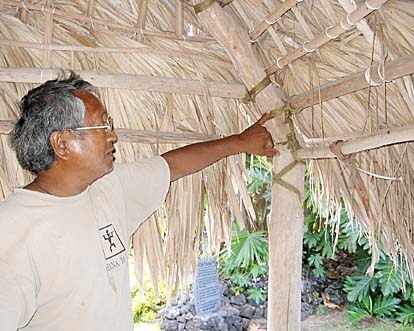
ASSOCIATED PRESS
Frank Sinenci points to the lashing that holds together a hale, in Hana, Maui. Demand for the traditional structures is growing in Hawaii.
Hale builders
face final exam
to begin profession
HANA, Maui >> The simple grass hut isn't so simple anymore.
The thatched Hawaiian hut known as a hale can require tens of thousands of dollars, a months-long wait and a builder with special certification.
Still, the structure once expected to go the way of the 95-cent Mai Tai is experiencing a rebirth here. Local building codes for the huts have been eased and demand is growing. And today, a new class of specially trained hale builders -- billed as the first such group in the world -- will graduate, eager to dot such indigenous housing across the islands.
"People don't want to come here to see skyscrapers," said Frank Sinenci, a master hale builder who shares the skill through his Maui Community College program. "Everyone thinks it's cool to have a Hawaiian house in Hawaii."
Sinenci, a 61-year-old former Air Force maintenance chief, has devoted the last decade to building the huts that have provided an image of Hawaii for millions.
It hasn't been easy. For years, getting the permits needed to build a Hawaiian hale meant stepping into a bureaucratic tangle. But last year, Maui County Council passed a bill giving indigenous structures the same legal standing as Western dwellings.
"It does something that I think Hawaiians have been asking for for sometime," said state Sen. J. Kalani English (D, East Maui-Lanai-Molokai), who worked on the legislation as a Council member. "It creates an equal footing for them. It's saying that we're not outside of the code."
Sinenci says an ancient builder could face death for improperly constructing a hale. Nowadays, rules are eased but still strict, with only certified hale builders who have taken the Maui Community College class allowed to construct the huts on the island.
Sinenci has been teaching 10 would-be builders since January and this weekend they face their final exam in a "Trading Spaces" meets "Amazing Race" feat. In addition to a written test, the group will have 48 hours to work together and construct a hale.
"Everyone's nervous," said Arnold Lono, 38, who took a sabbatical from his job as a botanical garden foreman to focus on the class. "It's like an initiation."
The task of constructing a hale actually begins weeks before the building commences.
Trees suitable for the frame -- usually ironwood -- must be harvested, stripped and dried, then treated in salt water to guard against termites. As many as hundreds of thousands of ti leaves must be gathered for thatching 10 to 12 inches deep. And when the supplies are in place, without using nails or screws, builders carefully erect the hut, held together by lashings.
The result is a structure Sinenci contends is far more sturdy than Western buildings.
Eight years ago, while finishing up a hale here in rural Hana on Maui's eastern coast, Sinenci said a windstorm was forecast and he decided to test his hut's strength by spending the night there.
The next morning, he says, the entire weeks-old roof blew off a nearby school. "I didn't lose one leaf," he said.
Hales can take many different forms -- from simple shelters similar to lean-tos to more intricate open-air structures almost resembling an A-frame home, with wood poles lining the perimeter and a steep thatched roof.
They can take up to three months to finish and generally cost $45 to $75 per square foot -- as much as $100,000 in all.
But Sinenci says he gets calls from many Hawaii residents seeking to add one to their property.
"Right now, there's a lot of people that want one as a status symbol," he said. "I don't care if you got the money. There's got to be a good reason why you want one."
The new county regulations bar plumbing and electrical wiring from structures built of grasses and leaves, meaning they are only suitable as an addition to a property that also has a regular house.
English, whose family has a hale, says he hopes they will again spread across the islands, becoming home to hula schools, charter schools, even public housing units.
Hales, with their precise specifications and often breathtaking surroundings, evoke a simple elegance. But not everyone greets them with the same respect.
Sinenci recounts a time when a visitor saw a hale he was building.
"He said, 'Wow, this is the Third World,"' Sinenci said. "No. This is the First World. This is the real Hawaii."
